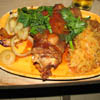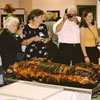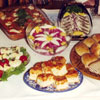Estonian Cuisine
Alberta's Estonian Pioneers
 Upon their arrival in Alberta, Estonian pioneers had two priorities - building shelter and acquiring food. For all pioneers who arrived in Alberta during the first decade of the 20 th century, there were no large grocery stores, no imported foods, and no pre-packaged foods. Very small shops and markets selling limited types of food were located far from the Estonian farms, often requiring a day or two by horse cart to get there. This meant that the pioneers had to grow and produce nearly all of their own food on their own farms. There were no refrigerators or freezers; people had to find other ways to preserve food so that they would have something to eat through the long cold winters. Pioneer farming was reflective of what the climate and soil conditions in an area allow. Both Estonia and Alberta have short, relatively cool growing seasons, so the early Estonians arrivals knew how to get their farms started here.
Upon their arrival in Alberta, Estonian pioneers had two priorities - building shelter and acquiring food. For all pioneers who arrived in Alberta during the first decade of the 20 th century, there were no large grocery stores, no imported foods, and no pre-packaged foods. Very small shops and markets selling limited types of food were located far from the Estonian farms, often requiring a day or two by horse cart to get there. This meant that the pioneers had to grow and produce nearly all of their own food on their own farms. There were no refrigerators or freezers; people had to find other ways to preserve food so that they would have something to eat through the long cold winters. Pioneer farming was reflective of what the climate and soil conditions in an area allow. Both Estonia and Alberta have short, relatively cool growing seasons, so the early Estonians arrivals knew how to get their farms started here.
For Estonian pioneers, work on the cultivation of grain fields began immediately so that rukkileib, black rye bread, could be produced. This was the basis for many meals among Alberta's Estonian pioneer families. Pioneers soon invented an assortment of gadgets to accommodate the production and storage of food. This was essential for maintaining a large supply of food over Alberta's long winters. One such example was the hand-cranked cabbage shredder that enabled the production of sauerkraut at an accelerated rate. One such cabbage shredder now belongs to the Glenbow Museum.
 Root vegetables such as carrots and parsnips were frequently stored in a barrel filled with sand. The barrel was then stored in a cool, dark cellar. Doing so would prevent animals from infiltrating the family's vegetable supply.
Root vegetables such as carrots and parsnips were frequently stored in a barrel filled with sand. The barrel was then stored in a cool, dark cellar. Doing so would prevent animals from infiltrating the family's vegetable supply.
Poultry (chicken, turkey, goose, and duck) was a popular dish among Alberta's Estonian settlers. It was not uncommon to see every part of the chicken used in a variety of different recipes, with the exception of the head. Farms were often equipped with their own smokehouses for the curing and smoking of meat including sausages, pork and chicken.
In the Medicine Valley, pioneers had access to an abundance of nearby fish which was a welcomed substitute for meat.
Traditional Estonian Foods
The country's northern climate defines much of Estonians' culinary practice of utilizing vast quantities of pork, potatoes, and root vegetables grown in the countryside. With its short and cool growing season, Estonians relied on a multitude of grains (primarily barley, oats and rye) as the basis for much of their diet. Estonian cuisine draws much of its influence from German and Russian recipes.
Grains
Rukkileib (black bread) can be found at every Estonian kitchen table regardless of geography or class. Leib is so important to the Estonian diet that many claim that "meat is only something that accompanies leib". The dark loaf, made from rye, has a distinctive sour taste adored by all. In a typical Estonian grocery store, there are 30 different varieties of leib from which to choose.
Vegetables
Kartulid (potatoes) are another staple ingredient in many Estonian dishes. Introduced in the 1700s, kartulid are a versatile ingredient that can be prepared in a variety of ways. Potato based salads are especially popular in Estonia, including "rosolje" which is rendered pink by the addition of beets. The most common vegetable in Estonia is cabbage, often converted into sauerkraut. Pickles, lingonberry jam, pickled pumpkin, and mushrooms are commonly consumed at mealtime with hazelnuts or filberts being a very popular snack.
Soup
Hernesupp (pea soup) is a popular soup prepared during the cold winter months. The dish contains dried peas, water, smoked pork shank or trotter, onion and sometimes barley. Cabbage soup is another favourite, especially the day after a lively party.
Meat
 Traditionally, pork is the meat of choice; it is frequently served with potatoes and vegetables such as cabbage and turnips. One particularly popular ham dish was prepared by maturing the pork in a sauna (steam bath house).
Traditionally, pork is the meat of choice; it is frequently served with potatoes and vegetables such as cabbage and turnips. One particularly popular ham dish was prepared by maturing the pork in a sauna (steam bath house).
"Sült" is Estonian style jellied meat. Often prepared for large gatherings, mostly it is made using pork, but can be made with veal, chicken or fish plus an assortment of spices for flavouring. It is cooked either making use of the natural meat gels produced during the boiling process or by adding the head or extra shank to the pot in order to enhance the amount of natural gel released. This form of meat is called "head cheese" in English, although in the 21 st Century, most Estonians throughout the world make "sült" without using any animal head. Sült is traditionally served at Christmas whereby it was custom to butcher pigs prior to the festive holiday. Sült is served regularly at Tallinn's famed restaurant, the Golden Piglet .
Another festive meal served on special occasions is black sausage, also known as blood sausage or Christmas sausage. Consisting of barley, pork cubes, fresh pig's blood, this national dish is enjoyed throughout Estonia with oven-roasted potatoes, stewed sauerkraut, and lingonberry jam or pickled pumpkin salad.
Some food historians consider Estonian style "pirukad" to be a possible forerunner of the hamburger. Pirukad begins with a delicate and savoury dough, rolled thin and cut into circles. The small circles are filled with either ground meat, egg, carrot, or cabbage, then either baked or deep fried. Pirukad can be eaten as finger food or as a meal traditionally accompanied by clear chicken or beef broth. Also popular are large rectangular pirukad which are cut into thick slices and eaten with a knife and fork.
Fish
As two-thirds of the Estonian border is adjacent to water, the consumption of fish is only natural. Fish is often smoked, salted, sundried or marinated. The most common varieties include smelts, brisling or sprats, perch, pike, trout, whitefish flounder and Baltic herring. Estonians are especially adept at various ways of smoking fish. Crayfish, a type of freshwater creature similar to lobster, is considered a real treat.
Dairy
Today, Estonians are moving away from consuming buttermilk and switching to the consumption of kohupiim , or cottage cheese, as a means of maintaining a calcium-rich diet. One can find close to 30 different varieties of cottage cheese in an average grocery store. An assortment of yogurts and cheeses are also quite common in Estonian homes.
Berries and Desserts
Estonians consume a variety of berries including blueberries, strawberries, red currants, black currants, gooseberries, cherries, cranberries and lingonberries plus great quantities of apples and plums. With land particularly suitable for a large variety of berry bushes, berries and berry-based desserts have been popular among Estonians for centuries. They would be eaten fresh with sugar and fresh cream; cooked as a preserve or they would be spread on special doughs to make a kind of open-face berry pie. Vastlakuklid (sweet buns) are a cream-filled pastry resonating with a distinct vanilla and almond flavour. Typically, this sweet dessert is served with whipped cream.
On special occasions, Estonian pioneer families prepared kringel, a traditional dessert featuring sweet dough, almonds and raisins. Today, many of the aforementioned ingredients are still used by Estonian descendants particularly during festive occasions.








